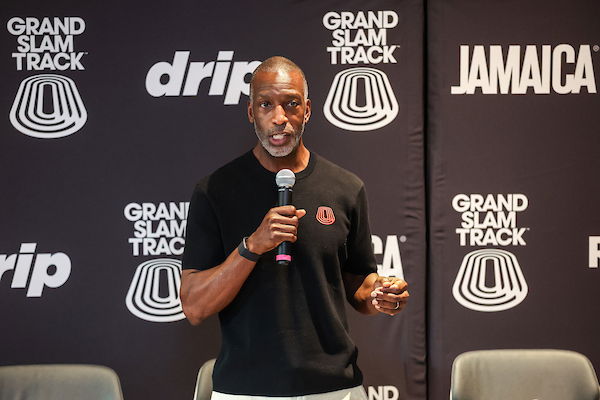

Michael Johnson had a vision. One that could’ve reignited global excitement for track and field. With Grand Slam Track making its debut in Kingston, he brought not just big names but big money. A stacked lineup, prize purses athletes have long begged for, and a stage steeped in sprinting history. It had all the ingredients of a historic night. Yet, when the lights came on at the National Stadium, something was missing: the crowd. Despite over 35,000 seats available and a sport the island is globally known for, the stands echoed with emptiness. And now, Johnson is speaking out.
Watch What’s Trending Now!
This wasn’t just a blow to the vibe. “It was a miss in terms of the crowd, specifically the turnout,” said Leighton Levy on SportsMax TV. And Johnson echoed the sentiment, disappointed not just in numbers, but in what it says about support for the sport. After all, it’s the same fans and athletes who call for change, for better pay, and for bigger platforms. Yet when someone like Johnson puts real money and effort on the line, the silence speaks volumes.
With the Philadelphia leg looming from May 31 to June 1, the clock’s ticking for answers, and now, the CEO and Commissioner of Grand Slam Track isn’t holding back his disappointment. Michael Johnson didn’t just want to sell tickets. He wanted a movement. And that’s exactly where the sting lies. After pouring resources into Grand Slam Track’s Kingston debut, the sprint legend couldn’t hide his surprise when a sea of empty seats greeted the athletes.
Despite selling 24,000 tickets across three days, only a fraction of that number showed up. Johnson, never one to sugarcoat, addressed it plainly, “We thought more people would turn out. We sold 24,000 tickets over the three days. That many people didn’t show up. So that was a bit surprising. It’s great that we sold the tickets, but we’d like the people to actually show up.”

For Johnson, it’s not just about revenue. It’s about creating an atmosphere worthy of the athletes and the sport’s legacy. And he has given those athletes something that’s been missing from track and field for far too long: stability. The Grand Slam Track series has reimagined the game. For the first time, professional sprinters dubbed “Racers” receive base salaries. That alone is revolutionary in a sport where most athletes live race-to-race, surviving on inconsistent prize money and elusive endorsements.
Add in a prize pool of $12.6 million, with a whopping $100,000 up for grabs in each event group, and Johnson has put real muscle behind his mission to modernize the sport. Even the field was innovatively split, offering unknown talents like Walmart employee Dylan Beard a chance at $65,000 glory in Miami. Still, it hasn’t all been smooth running. The Kingston meet, despite blockbuster performances from stars like Sydney McLaughlin-Levrone and Danielle Williams, was overshadowed by empty stands and drama off the track.
Fred Kerley’s arrest at the meet hotel added unwanted noise, and GST’s pledge to ditch paper bibs stumbled right out of the gate. Analyst Leighton Levy summed it up best: “It was a hit in terms of the performances but a miss in terms of the crowd.” Johnson, reflecting on the discrepancy between energy and attendance, has stayed firm in his call for true support.
Grand Slam Track adapts ahead of Philly stop
As the spotlight shifts to Philadelphia, anticipation for the third Grand Slam Track Meet is already heating up. The star power is undeniable! Sydney McLaughlin-Levrone, Fred Kerley, Gabby Thomas, Grant Fisher, and Josh Kerr headline a field bursting with Olympic pedigree. With coverage secured on both The CW and Peacock, this event has the makings of a blockbuster.

Yet before a single race begins, Grand Slam Track finds itself under fire again. Not for logistics or attendance issues, but for something more rooted in the city itself: affordability. Despite Michael Johnson addressing every logistical concern. Parking, traffic, scheduling. The cost of simply staying in Philly has fans grumbling. With nearby hotel prices soaring well above the $200 mark in some cases, many are wondering whether the track’s shiny new league is pricing out the very fans it’s trying to win over.
In response to the growing concern, GST made a bold call just two weeks ahead of race day. On the social media platform X, organizers announced a major format change: “We tightened it up. Two days. All thrill, no filler. More racing, better pacing—for fans and athletes.” May 30 was scrapped, condensing the event into just two action-packed days, May 31 and June 1.
The message was clear! GST is paying attention. The move wasn’t just a scheduling change; it was a direct answer to criticism that the original three-day setup felt more draining than dynamic. For a league priding itself on being modern and fan-first, this quick pivot might just be one of its most strategic plays yet. It’s not every day you see a league shift gears mid-season, but Grand Slam Track is proving it’s unafraid to rewrite the rules.
Fans had voiced concerns that the event’s original pacing felt more like a slog than a spectacle. GST listened and acted. Whether this gamble delivers the kind of electric energy Johnson envisions in Philly remains to be seen. But one thing is certain: this is a league that’s evolving in real time, keeping its promise to put athletes and fans at the center of the sport’s rebirth.
ADVERTISEMENT
ADVERTISEMENT
ADVERTISEMENT
ADVERTISEMENT

